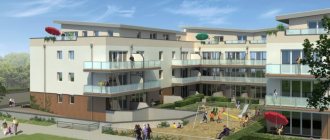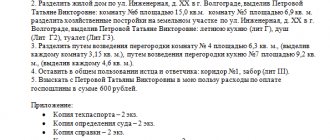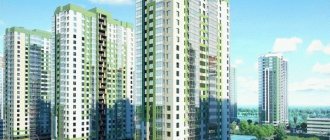Real estate owners have the right to obtain ownership of a land plot under high-rise and low-rise buildings. Privatization of land under an apartment building will help citizens jointly manage the territory located under the building.
What is an apartment building is a building with non-residential premises and a certain number of apartments and floors, intended for living. The classification of buildings depends on the type of house, length and number of floors. Long houses consist of several entrances, point houses have one.
According to the Housing Code, the land under an apartment building is common property. Residents can dispose of it, since it is considered common shared property.
The Land and Town Planning Codes establish the boundaries of the site. Rosreestr registers title documents for land and provides information about rights holders.
Federal Law No. 189 of December 9, 2004 enacts the Housing Code of the Russian Federation and regulates the privatization process. If the land under a residential building is not the property of the owners, then privatization is carried out. To do this, an application is submitted to state or municipal authorities and ownership is registered.
Who can apply
To carry out the privatization procedure, a general meeting of apartment owners is held and a representative is elected. On behalf of all owners, he submits an application to the authorized body for privatization. The process of transferring ownership of a plot of land under an apartment building can be initiated by one of the residents. This is established by law on the basis of a resolution of the plenum of the Supreme Court of the Russian Federation: The Constitution provides for the right of every person to protect his rights and interests, if they do not contradict the legislation of the Russian Federation. If one owner is denied privatization, this is contrary to regulations and is a violation.
How to act for apartment owners: step-by-step instructions
Re-registration of a plot of land under an apartment building into the ownership of residents occurs according to a standard scheme consisting of several stages.
Holding a general meeting
Conducting a general meeting of house residents is a primary task in the process of land privatization.
In order for the meeting to be considered valid, at least half of the property owners or their legal representatives must be present.
If for some reason it is not possible to assemble the required quorum, it is also permissible to conduct a vote of residents in absentia by distributing printed forms to the owners.
The initiator of the meeting can be any of the residents who are ready to take on all further organizational issues. Owners must be informed about the meeting and its agenda at least 10 days before the scheduled date.
At the meeting itself, the organizer must:
- tell residents about the possibility of land privatization, as well as the pros and cons of this procedure;
- conduct a vote that will determine the attitude of the owners to the proposed re-registration of the site;
- record the results in the minutes of the meeting and collect signatures from all its participants;
- if residents support the initiative, a responsible person is immediately identified who will prepare documents and monitor the privatization process.
Responsibility for falsifying the protocol
Today, the minutes of a meeting of apartment building residents is a legal document, the authenticity of which can be verified by officials. If it turns out that the protocol was falsified in order to privatize a plot of land under an apartment building, its compiler will face criminal liability under Article No. 327 of the Criminal Code of the Russian Federation - “Forgery, production or sale of counterfeit documents.”
For forgery of documents, penalties may be imposed in the form of:
- imprisonment or restriction of freedom for up to two years;
- forced labor for up to two years;
- arrest for up to six months.
Submitting an application
The next step should be to contact representatives of municipal authorities. But first you will need to fill out an application in which you must indicate:
- Full name and contact details of the person representing the interests of the residents;
- the exact address where the land plot is located;
- the category to which the land belongs;
- presence or absence of encumbrances;
- a list of buildings located in the local area;
- details of ownership of all listed structures.
The application must be signed by the meeting participants who supported the initiative to privatize the land.
Package of documents
Along with the application, you must provide a standard set of documents, which includes:
- a copy of the applicant’s identity document;
- copy of TIN;
- a copy of the minutes drawn up based on the results of the residents’ meeting;
- registration certificate for the house, cadastral documents;
- documents confirming ownership of an apartment or land;
- floor plan of an apartment building.
Formation and scheme of memory
If, before the privatization of the plot, its formation has not yet been carried out, to continue the procedure it is necessary to carry out land surveying, and after that – cadastral registration.
During the survey, the area of the site will be determined, its exact boundaries will be established, which must comply with urban planning regulations and not violate the rights of neighbors.
Municipal authorities must provide land surveying services based on applications from citizens. All work on delimiting the territory is carried out by an engineer.
Registration in the state cadastre
After completing the land surveying procedure, it will be registered with the regional cadastral register. The territory, which has an exact area and boundaries, will be included in the cadastral passport. To carry out this procedure, you need to contact the Cadastral Chamber, providing:
- technical passport of a residential building;
- apartment building plan;
- drawn up boundary plan;
- minutes of the residents' meeting.
State registration
The final stage of privatization will be state registration, which will officially confirm the right of residents to own land under the apartment building. To register, you can contact Rosreestr directly or register through the multifunctional center (MFC). At this point, the process of transferring the land into joint ownership of the residents will be considered completed.
What rights do owners receive by privatizing a plot for an apartment building?
Having received ownership of the land, the rights holders can sell or lease it to local administrative authorities for the construction of a shopping and entertainment center, the construction of an office building and other needs.
When privatizing the local area, homeowners in an apartment building receive not only the rights to use the property, but also responsibilities. The right of ownership imposes obligations on the owners to pay land taxes, therefore, utility bills increase. Having received registration of ownership of the plot in the Unified State Register of Real Estate, residents can dispose of the land at their own discretion, for example, improve it: build a children's playground or sports ground. Ownership of a plot gives the right to receive income from its use.
How can you use the privatized territory near your home?
The law strictly defines the types of use of land related to apartment buildings:
- landscaping of the territory (construction of playgrounds, installation of sports equipment, arrangement of recreation areas, landscaping of the yard, etc.);
- provision of individual plots for rent (for advertising structures, construction of commercial real estate, etc.);
- construction of garages for WWII veterans and disabled people;
- organization of parking spaces for residents of the house and their guests.
However, it is worth remembering that all buildings and objects being erected must not contradict legal norms. The norms of distances between buildings must be observed, and the rights of third parties must not be infringed. For example, if there is a passage through your yard to a public transport stop (the only one), and you fenced yourself off and made entry to the territory with passes, then in court you will be obliged to provide passage to residents of neighboring houses.
Example. Residents of one of the apartment buildings in Saratov privatized the adjacent territory. The right to manage the land plot was transferred to the chairman of the HOA. In order to raise additional funds for the maintenance of the house, he arranged paid parking for residents of neighboring houses. However, he did not coordinate with the responsible authorities; he accepted parking fees as voluntary sponsorship. A criminal case was opened against the chairman, and the prosecutor's office ordered the abolition of paid parking.
Positive and negative points
Owners of the local area adjacent to the building must understand that privatization of the site implies certain responsibilities and obligations. As a rule, residents do not have a common opinion in their desire to establish and register ownership.
Let's look at the main advantages and disadvantages of the process.
Positive sides:
- privatization is carried out without material costs on the basis of legislation;
- Only the owners have the right to dispose of the territory under the MKD;
- making a profit from renting land;
- profitability of real estate.
Minuses:
- expenses for paying land tax;
- material costs for maintaining the site: repairs, landscaping;
- restrictions on land use: construction of garage cooperatives for WWII participants, disabled people, construction of recreation areas for children and sports facilities.
Material costs for taxation and maintenance of the site are distributed among the owners. Thus, residents decide to establish boundaries and rights to the site collectively, discussing the pros and cons of the procedure at a general meeting.
Is it possible to privatize the land under an apartment building?
According to Art. 36 of the Housing Code of the Russian Federation, the land area next to the apartment building belongs to the property of the house .
The standard area of a high-rise building includes the land under the house itself, as well as landscaped areas nearby: places reserved for drying clothes, parking lots, children's playgrounds, etc. (Resolution of the Government of the Russian Federation No. 491 of August 13, 2006).
After the privatization of land under MKD, apartment residents have the right to dispose of their property according to the right of shared ownership . As a rule, in such a case, management of land property is entrusted to management companies or HOAs.
At the same time, it should be understood that the land under the MKD must have clear boundaries and comply with the Urban Development Plan.
Privatized land always has a cadastral passport, which indicates:
- square;
- boundaries;
- distinctive features;
- purpose and other parameters.
If there is no cadastral plan for the land, then the above characteristics are displayed in the technical plan for the apartment building.
Privatization algorithm and authorities for appeal
In large settlements and cities - to the authorized bodies for property and land issues, divisions of departments. In the village - to the village administration. When applying, you must provide the necessary documentation and application.
Let's look at how to properly privatize land under an apartment building.
Step-by-step instructions:
- organizing a general meeting of residents to consider this procedure;
- an application is sent to the head of the authorized body based on the collective decision;
- a technical and cadastral plan of the land is prepared;
- appeal to the land issues committee after receiving permission from the administrative authority;
- documents received from the land committee are provided to the city or village administration;
- the municipal institution analyzes the provided documentation and makes a decision on the possibility of privatization;
- the boundaries of the land are determined and noted in the technical documentation;
- the administrative commission signs an act authorizing the registration of ownership of the property;
- An application for obtaining title documents is submitted to the registration chamber.
Just one time
As you know, the law allows privatization of housing or land free of charge once. If a citizen already owns a plot of land, then the collective form of privatization will be the most suitable in this situation.
Issued for free:
- land plots provided for development before 2001;
- lands owned by horticultural societies;
- a plot of land for an apartment building built before the beginning of this century;
- local area;
- an allotment received by inheritance or will.
For registration of a plot of land under a high-rise building built after January 2001, you will have to pay a tax. Its value will be calculated during the assessment of buildings and land. You will need to additionally collect several more documents and certificates.
List of documents and sample application
Citizens can find out what papers owners need for privatization by calling the local administration's advisory line or personally visiting the institution.
Scroll:
- cadastral passport for land;
- topographic survey of the territory;
- area plan indicating boundaries;
- documents confirming the right of land use: land registration, administrative acts for the right of use and others;
- a certificate with assessment data is provided by the authorized body on land issues;
- issuance of papers with information on the area and volume of taxation - falls within the competence of the tax inspectorate;
- the technical examination bureau provides a certificate of the market value of the object;
- passport, TIN of the applicant;
- cadastral documentation for MKD;
- Extract from the Unified State Register of Registered Land Rights.
The land cadastral passport is the main document. In its absence, the owners will have to incur costs for processing additional papers. The law provides for the drawing up of a site plan with the entry of cadastral data on the basis of title documents. The application is drawn up according to the established template. The necessary documentation is attached to it. The local government body registers the application. The sample can be viewed on the Internet on the website of the administration or MFC.
Registration in Rosreestr
Documents and an application to Rosreestr can be submitted in several ways; you should choose the most convenient one.
- If possible, you can take the papers directly to the local Rosreestr office. Sometimes on-site receptions are carried out by the authorized body of this body; you can also hand over documents to him when he is working on the road.
- The application is sent with papers and postage. Be sure to indicate the value of the parcel and describe the attachments. Notification of delivery and receipt of the parcel is required.
- A convenient way is to send it by email through a special service - the official service of Rosreestr.
For the registration and registration procedure, you must pay a state fee; a receipt for its payment is sent along with the application.
Material costs during registration
The privatization process is carried out free of charge.
Paperwork involves material costs:
- upon receipt of cadastral documentation, material costs will be approximately 10,000 rubles;
- the cost of technical documentation varies depending on regional BTI prices;
- registration of rights in the Unified State Register of Real Estate – 500 rubles;
- legal entity – 2,000.
It is worth noting that the cost of services must be clarified in regional divisions.
Pros and cons for residents
Privatization has a number of advantages for residents, but it also has disadvantages - before carrying out the procedure, it is worth weighing both and deciding which is more important. And for this you need to know in detail both all the pros and cons.
Let's start with the first ones:
Privatization itself is free, that is, the land will not have to be purchased - although registration will cost some money. Having privatized the territory, residents become its owners, which means they will acquire the right to dispose of it, including for obtaining material benefits. For example, it is allowed to rent out this land
In addition, the sale price of an apartment will be higher when the territory of an apartment building is privatized than if this procedure has not yet been completed. It is equally important that only its owners will have the right to dispose of privatized land - the municipality will not be able to use this land to build something on it, lay a road, or for other similar purposes, since both for construction and for the newly existing building You will need to obtain permission from the owner. This is extremely useful for protecting the peace of residents. Residents will be able to freely engage in collective landscaping of the site, for example, organizing a lawn, flower beds, arranging parking, installing sports and children's facilities - all this will be their property
Typically, such work is much more effective than the efforts of the municipality, and if residents want to see a landscaped area around them, and are ready to do this, then the first step should be its privatization. Privatization guarantees more impressive compensation if the house needs to be demolished, since the land will first have to be forcibly confiscated from the residents.
The advantages are quite significant, but in the end their value depends on the situation and the priorities of the citizen. Sometimes the disadvantages can outweigh them, because they also exist:
- You will have to pay tax - its amount depends on the subject of location, and is tied to the cadastral value. If the land is rented out, then taxes on profits must also be paid.
- The owners will have to maintain the site themselves, carry out its landscaping and cleaning. Moreover, if all this is not performed at the proper level, for example, garbage is not removed on time, the snow in front of the house is not cleared, then a penalty may be made. Usually these concerns are transferred to the management company - then you will need to negotiate them separately and pay for them separately, while if the land is not privatized, then this is the concern of the municipality.
- At their own expense, the owners will have to carry out repairs of objects located on this land, for example, the same elements of the playground.
- The use of privatized land is permitted only for its intended purpose, which greatly reduces the possibilities for commercial use, and even for independent development. In fact, the possibilities are usually limited to the construction of playgrounds for children or recreation areas.
In general, after the site passes into their hands, residents receive greater opportunities to dispose of it, but at the same time, the requirements for them themselves increase. Therefore, this option is suitable for houses with proactive residents who are ready to take on the costs and responsibilities that will fall on them due to privatization. If there is a lack of such, it is worth considering again whether it is worth doing it at all. We emphasize that, first of all, the costs of registration and subsequent maintenance will be noticeable if the house is small, but for residents of large apartment buildings they are hardly noticeable.
Deadlines
Local authorities make a decision on the possibility of privatization no later than one month from the date of registration of the application. Cadastral and technical passports are produced within 14 days. Technical documentation is necessary to determine the share of territory for each resident. The registration process in the USRN takes two weeks. Submitting an application to establish rights through the MFC takes about 0 days.
Deadlines for reviewing and processing documentation:
- application from the owners for privatization of the site - 30 days;
- cadastral passport – 14 days;
- technical passport – 14 days;
- registration of ownership in the Unified State Register of Real Estate through Rosreestr – 14 days;
- registration of property rights through the MFC – 17–20 days.
Reasons for refusal
Since the adjacent territory is often a desirable acquisition not only for owners of apartments in a high-rise building, but also for developers of various commercial real estate, there are often situations when it is necessary to go to court in order to finally delimit the ownership of the land. Therefore, privatization may be refused if the territory near the house is the subject of legal proceedings.
Another common reason for refusal is the lack of a boundary plan or cadastral passport of the site. After completing these documents, you have the opportunity to again submit an application to the municipality for the privatization of a plot of land near your house.
If all the documents are in order, then you most likely will not receive a refusal to privatize the common area - it is beneficial for local authorities to shift the responsibility for maintenance onto the shoulders of home owners.
But if, nevertheless, you were refused, and you think that it was unreasonable, then file a claim in court - this is the only authority that can put an end to the dispute about privatization.
Difficulties in generating documentation
At the general meeting, not all residents can come to a consensus on the need to privatize, since there is a responsibility for the maintenance of the common privatized property and material costs for registration and taxes.
The land for the building was provided illegally. This is usually determined by document analysis by authorized institutions.
In the absence of cadastral or technical documentation, the time frame for preparing a package of papers is extended. Employees of the BTI and cadastral service are called to the site to register new ones.
If the owner's representative has not provided documents certifying his authority, the process is impossible. When controversial situations arise, owners turn to the courts.
Determine your benefit
Complete instructions for registering a land plot with illustrative examples were presented on September 27 at the webinar “Registration and maintenance of a land plot” by Elena Shereshovets.
She advised that before starting work, choose the house for which they will be carried out and answer a few questions for yourself.
Determine what legal status the land plot has today. Analyze how beneficial this will be for you. If you have come to the conclusion that registering a land plot is beneficial for you, develop an action algorithm:
- choose who will deal with the problem, determine his powers;
- designate an executive body that will help carry out the work;
- understand when the moment of transfer of ownership comes - from that moment you will have new rights and obligations;
- determine the size of such area;
- analyze possible difficulties and ways to solve them.
The most important thing to do first is to determine the size and boundaries of the land plot in order to clarify its legal status.
Important points
Land transferred to private ownership must be used by all residents. There is no share allocated per person. Completion of a transaction for the sale of an apartment involves the transfer of land rights to the new owner. The land owned by the owners cannot be sold separately from the building.
The Constitution of the Russian Federation presupposes the right of residents to own and dispose of the territory. Registration of title to a residential property determines the right to the land under the house. An apartment building on a privatized site may be designated for demolition based on a decision of local authorities. When living in a cooperative building, the area under the house is leased; after the expiration of the contract, it is possible to register the plot as property.
By ordering an extract from the Unified State Register of Real Estate, you can get an answer to the question: who can own the land under the house?
Taxes
Article 338 of the Tax Code of the Russian Federation defines the procedure for establishing the amount of tax fees for a site located near an apartment building. Local regulations also influence the size and procedure of payment.
The tax is determined based on the base land tax rate, cadastral value and local coefficient. Therefore, different amounts of mandatory tax may be charged for the same area of land in different parts of Russia.
You must pay the tax once a year. Individual entrepreneurs and legal entities are required to pay the tax fee themselves, and individuals are calculated and notified of the payment amount, date and method of payment by the Federal Tax Service of the Russian Federation.
Entering information into the State Property Register (state real estate cadastre) for previously registered plots
Before taking any action, you should find out whether the house has land ownership. Information can be obtained on the official Internet platform of Rosreestr. It is possible to order a certificate from the MFC (multifunctional center).
The lack of information about land allotment in the State Property Committee does not mean that such information does not exist at all. Perhaps the site is one of those previously registered, and then there is the right to register the privatized land in a simplified manner.
The previously recorded land plots include:
- Information about which, in accordance with regulations, was entered into the cadastre until 03/01/2008.
- Not registered in the cadastre, but with rights registered to them and assigned conditional numbers.
To carry out the procedure, you must submit an application and attach the available documents to it. Their list is unlimited. A prerequisite is the presence in such papers of information about the area of the allotment. Another requirement is that the document is issued by an authority with due competence, and it must comply with the legislation in force at that time. For example, this could be an inventory file created between 1993 and 1998.
After registering the newly formed plot in the cadastre, it becomes the common property of all owners of the premises in the apartment building.
Since the entry into force of the Housing Code, persons involved in the construction of apartment buildings cannot begin construction of a facility without properly registering a land allotment.
Thus, the answer to the question of whether it is possible to privatize a plot of land located under an apartment building is obvious: it is possible to do this and will not be difficult.
Who is allowed to privatize the adjacent territory in an apartment building?
H° ÃÂðÃÂÃÂúð, ÿÃÂøûõóðÃÂÃÂõóþ ú Ã¼Ã½Ã¾à ³Ã¾ÃºÃ²Ã°ÃÂÃÂøÃÂýþüàôþüÃÂ, òÿÃÂð òõ ÃÂðÃÂÃÂÃÂøÃÂÃÂòðÃÂÃÂ:
- The A µÃ³Ã°ÃÂÃÂøõ ú ýõüàÃÂÃÂÃÂþõýøÃÂ;
- òûðôõûÃÂÃÂàúþüüõÃÂÃÂõÃÂúøàøû ø öøûÃÂàÿþüõÃÂõýøù, ÃÂðÃÂÃ¿Ã¾Ã»Ã¾à ¶ÃµÃ½Ã½ÃÂàò ÃÂÃÂÃÂ;
- ûøÃÂþ, ÃÂÿþûýþüþÃÂõýýþõ ÃÂþñàÃÂòõýýøúðüø ôþüð;
- ÃÂÿðòûÃÂÃÂÃÂðàúþüÿðýøÃÂ;
- The øüðÃÂõûø ø ÃÂÃÂøôøÃÂõÃÂúøõ ûøÃÂð;
- óÃÂÃÂÿÿð ÃÂþñÃÂÃÂòõýýøúþò, ôõù ÃÂÃÂòÃÂðàûøÃÂýþ øûø ÃÂõÃÂõ÷ ÷ðú þýýþóþ ÿÃÂõôÃÂÃÂðòøÃÂõûÃÂ.







